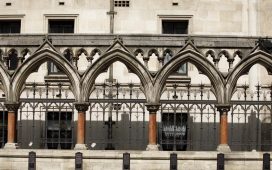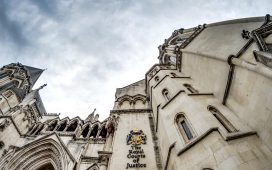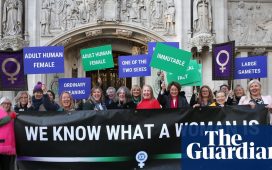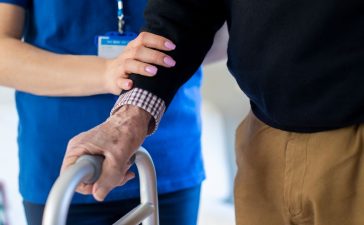Geo, the name he prefers, sits in a coffee shop on a rainy afternoon as streetcars clang along outside. He is 64. He arrived at Madonna Manor, the Catholic orphanage he is now suing, in August of 1967, as a ward of Louisiana, age seven.
“My childhood was horrific,” he says matter-of-factly. “My father was an abusive alcoholic, my mother diagnosed as paranoid schizophrenic. Madonna Manor was a place where dysfunctional parents dumped their children. My mom was subject to electroshock therapy and thorazine. She lost a baby. She had a psychotic breakdown and was placed in a mental hospital. The state took me over.”
Thin, bearded, redolent of nicotine, he holds a sketchbook of his works.
He enjoys the fellowship of a drawing class once a week, sketching figures of live models. Alcoholics Anonymous helps too, he says, adding: “I have been sober since May 30 and intend to go a long way sober.”
Existing on a disability check and earnings from his sporadic art sales, Geo lives on one side of the shotgun-style house where he grew up. His brother, a survivor of the same orphanage, lives on the other side. Neither man has children.
Madonna Manor and its sister facility, Hope Haven, occupy Spanish mission-style buildings on opposite sides of Barataria Boulevard in the New Orleans suburb of Marrero.
From the time he entered the now-shuttered complex, says Geo, the “sexual and physical abuse was constant”.
Sister Martin Marie was “a huge, ugly, mean woman we called Mastadon behind her back”, he said of a nun who worked there. “The nuns had a sadistic streak. Martin Marie liked to whip out a fold-out army shovel and beat us.”
He sips from a cappuccino sitting next to his sketchbooks.
“She was famous for grabbing and abusing us for sexual pleasure. A lot of these women – those nuns – had severe problems,” he adds.
Charles Earhardt, a bus driver and volunteer presence at the home, began molesting Geo immediately after the boy arrived, he says. Earhardt, named by several other survivors as a pedophile, was dismissed from his duties. Yet somehow he managed to adopt two boys – and, in short order, abused them, too, according to documents produced during a memorandum that led to a $5.2m settlement between the church and orphanage abuse claimants.
The Guardian gained access to that memo, written by attorneys Frank LaMothe, Roger Stetter and Michael Pfau – the representatives of 18 orphanage victims – to a court-approved mediator also working with lawyers for the Roman Catholic archdiocese of New Orleans and Catholic Charities, which oversaw Hope Haven and Madonna Manor.
The memo not only contains that incomprehensible revelation about Earhardt. It also makes clear that there were more abusers – and more victims – than ever known at two orphanages that have come to embody the scourge of clergy molestation in south-east Louisiana.
An institution out of control
The sheer scope of the institutional sexual abuse that the Catholic church in New Orleans concealed at the orphanages alone beggars belief.
“The institution was … out of control, had no safeguards to protect the children, and was a haven for pedophiles,” wrote LaMothe, Stetter and Pfau in a 2009 report to the mediator helping them negotiate with the church attorneys.
Earhardt is now dead. So is Sister Martin Marie and seven other nuns accused of physical and sexual abuses while Earhardt and 13 other male predators sexually traumatized boys at the orphanages, according to the narrative in the settlement memorandum, anchored in files that church attorneys provided in the discovery phase of the litigation.
New Orleans archdiocese spokesperson William Kearney told the Guardian that while the organization maintains a list of ordained clergymen faced with substantial allegations of child molestation – the church was not responsible for publicizing the names of nuns or religious brothers. That should be done by their respective orders, Kearney said. But the website of the School Sisters of Notre Dame, the religious institute which staffed the orphanages, has no such listing – and the order declined to answer why that was.
Kearney did say that the names of accused molesters at Hope Haven and Madonna Manor had been published in an August 2005 report by New Orleans’ Times-Picayune newspaper, in connection with a prior legal settlement.
But, despite its stated commitment to transparency with respect to the worldwide Catholic church’s decades-old and ongoing clergy abuse scandal, the archdiocese itself provides no accounting on the perpetrators at Madonna Manor and Hope Haven – whose abuse caused the organization to pay some survivors more than $5m in legal settlements so far.
“We encourage adults who were abused as minors to come forward to us and make reports directly to law enforcement agencies with our pledge of continued cooperation,” Kearney said.
Meanwhile, of the 14 men identified in the documents by LaMothe’s law firm, 12 are not on the church list. Only four are confirmed to be dead.
Notably, among the living is Gilbert Gauthe, the ex-priest who spent 10 years in prison for abusing youths in the Catholic diocese of Lafayette, Louisiana, kicking off the US church’s reckoning with clergy abuse in the late 1980s. His last known residence was San Leon, a town near Galveston, Texas. As a seminarian at Notre Dame in New Orleans, he allegedly molested youths at Madonna Manor. Gauthe is not listed on the New Orleans archdiocese’s list of 78 predators.
Another alleged and living orphanage abuse perpetrator, Brother Harold Ehlinger, was last residing at a Holy Cross order religious house in Austin, Texas. He is not on the church’s list, though he is named as a child sexual abuser in current lawsuits filed against the church.
Of the alleged perpetrators of youths who lived at the orphanage, the archdiocese lists Father Patrick Brady, who died in 1999 – but not in connection with Madonna Manor. Boys from the orphanage allegedly spent time with him at St Dominic’s church in New Orleans.
One other cleric on the list, John Sax, removed from ministry in 2004, has a list of 14 parish assignments. But there is no reference to the orphanages.
LaMothe and his clients believe it is wrong for the archdiocese to omit orphanage sex abuse perpetrators from its list of credibly accused abusers, given the more than $5m spent in settling cases at Hope Haven and Madonna Manor so far. They see that omission as another brick in the wall of secrecy and deception that today surrounds the New Orleans archbishop, Gregory Aymond, whose archdiocese filed for bankruptcy protection in 2020.
There are more unresolved claims of abuse at Hope Haven and Madonna Manor that are on pause because of the bankruptcy. A federal court order resulting from the bankruptcy generally shields church files from public view, including more recent orphanage abuse claims. Documents in the 2009 cases reviewed by the Guardian are not restricted by that order.
‘A desire to escape’
Geo knows the secrets at Madonna Manor all too well. He endured nearly four nightmarish years there. He opens his sketchbook. One of his pictures is a quadrangular figure with a radiant yellow core, the outer layers of red, green, yellow hover over a bed of pebbles underwater.
Color, nature, hope.
A different image has floated through Geo’s memory since the boyhood years when Sister Martin Marie, Earhardt and others worked him over.
He is in a bathrobe, at night, sneaking along Barataria Boulevard. He is trying to escape, something several other men – boys back then – have said they did. He is caught, taken back and beaten. In the dream, a man in a truck sees the boy, carries him back to Madonna Manor and hands him over to Sister Martin Marie.
“Is that fantasy, or a real memory? But it occurs, a desire to escape,” Geo says with a voice raggedy from decades of cigarettes.
“The symbolism is quite obvious.”
The lack of reprimands from the top makes him think the nuns never reported the abuse at the orphanages to administrators.
“Otherwise I would know it was real,” he continues. “I have had that dream on and off since I left.
“When they make you pull your pants down to get hit in the butt by a shovel, I consider that psychosexual abuse. Sister Martin Marie did that to me. It was not a dream.”
A separate Madonna Manor survivor who arrived several years after Geo left told the Guardian that Sister Martin Marie would tie a rope around his genitals and pull it to inflict pain if he resisted performing oral sex on her. It happened often, he said.
Geo was released at age 11 to live with his father. He went to public schools and attended the University of New Orleans and a community college for several semesters without graduating. During those years, he fell in love with rhythm-and-blues music by Fats Domino, the Neville Brothers and the keyboard wizard James Booker, and enjoyed going out to nightclubs.
Without a degree, he had limited options. “I worked as a bus boy, a dishwasher, house painting,” he says. “I’ve had countless jobs. Living hand to mouth, at least I had a place” – with his father, who is now deceased.
His brother received a $25,000 check from a negotiated settlement with other victims several years ago. Geo contacted his brother’s attorney – LaMothe – who now represents him in a claim for damages tied up in the church’s bankruptcy.
The cover-up
As this Catholic archdiocese’s bankruptcy grinds toward its fifth year, the contours of a vast criminal sexual-abuse underground lie in sheltered personnel files, as several lawyers for some of the case’s 530 victim-plaintiffs have asserted.
Aymond has identified fewer than 80 “credibly accused” clerics with limited information posted about them. A secret memo that victims’ attorneys gave law enforcement officials lists 300 perpetrators, including nuns and lay staff.
The church lists only men.
Yet in 2009 the same church paid a $5.2m settlement to 18 survivors of the two orphanages – men who gave graphic accounts of horrific abuse they suffered as boys by seven nuns, along with a string of male predators who preyed on them. The abuses ran from the 1940s through the 1970s.
Roger Stetter, who launched the litigation for the orphanage survivors and brought in LaMothe, told Religion News Service at the time: “We’ve had to fight the church tooth and nail for more than four years to acknowledge wrongdoing.”
Although it paid $5.2 to settle those cases, the church has not named the perpetrators at the orphanages to its list.
“Many boys were sexually abused by more than one person, and were often abused in front of each other at off-site camps and in the on-campus homes of the orphanage workers, seminarians and … priests” belonging to the Salesian order in charge at Hope Haven and Madonna Manor, LaMothe’s team wrote in documents filed during the mediation of the settlement.
Of the four off-site facilities, the school associated with the archdiocese’s spiritual home – the St Louis cathedral – was one where boys said they were abused by the lay choir director. The perpetrators also “included nuns” of the School Sisters of Notre Dame who staffed the orphanages for years.
Every single parish across the map of this archdiocese had at least one pedophile priest, according to plaintiff attorney Richard Trahant. Some had several predators.
Survival
A “Madonna Manor abuse chart” of three mind-numbing pages submitted by LaMothe, Stetter and Pfau for the 2009 settlement lists names and places that are now of interest to law enforcement investigators.
When the early cases settled in 2009, Aymond said in an interview: “It’s important that these wrongdoers come to light and that we admit that as far as we can tell, [the claims] are true.”
Aymond’s words sent a signal to other survivors of the orphanages, who have been stalked by memories of trauma.
“Aymond was trying to wipe the slate clean,” LaMothe said. “He was trying to show the church was being gracious and caring in settling the claims. But new people came forward. Today the church looks like it’s riddled with things that have not been uncovered. Aymond looks as bad as anybody.”
LaMothe and his colleagues settled a second wave of lawsuits for about 45 survivors of the orphanages in 2011 for an undisclosed sum.
In January 2020, before it filed for bankruptcy, the archdiocese paid $325,000 to resolve a case that LaMothe brought, accusing Sister Martin Marie, priest and facility director Raymond Hebert, and others who worked at Hope Haven and Madonna Manor decades ago.
Hebert had been accused by five men in the 2009 litigation. But the priest – who lived on the grounds for several years and headed Catholic Charities, which oversaw the orphanages – filed a countersuit, claiming he was innocent and that the allegations were defamatory. As a tactical move, LaMothe and his colleagues dropped the allegations against Hebert in order to secure the $5.2m settlement.
Hebert – who became then archbishop Philip Hannan’s adviser on clergy predators in the 1970s – testified in a deposition that he destroyed all his notes pertaining to abuse at Hope Haven and Madonna Manor. He died in 2014, three years after Hannan did.
Pending claims by orphanage abuse survivors call Hebert a predator. And Hebert is a conspicuous omission on the archdiocese’s list of suspected predators.
The church’s strategy in the bankruptcy filing was to essentially bury its personnel files and settle outstanding abuse claims as cheaply as possible. Judge Meredith Grabill’s protective order sealed the files in keeping with bankruptcy proceedings that give a corporate defendant time to reorganize assets to pay creditors.
Certain plaintiffs’ attorneys contested the moral logic of the shield, providing a secret, unsigned 48-page memo to law enforcement officials on the staggering scope of sex crimes and cover-ups by four archbishops over decades. Louisiana state police eventually served a sweeping search warrant on the archdiocese after the Guardian publicly exposed the existence of that memo.
LaMothe, who was not party to the memo, says that his office has given state police copies of its files on the orphanages.
The church’s bankruptcy strategy has been a disaster. It became a feedbag that dispensed $40m – and counting – to various professionals, including its corporate lawyers. Abuse claimants ensnared by the bankruptcy have not gotten a cent – and neither have their attorneys.
There is no resolution in sight. And in a sluggish real estate market, “for sale” signs of church property dot the region.
The media coverage has been bruising. At one point, in a stunning scene, state police carted off some church files past an archdiocesan yard sign reading: “God chose you to protect his children.” Chancery staff had to scan other files.
“A criminal search warrant trumps the bankruptcy shield,” LaMothe said.
Aymond told The Times-Picayune that all archdiocesan abuse files would one day be publicly released. Whether that happens, or when, is anyone’s guess. A relatively new state law – upheld as constitutional in June – gives survivors an extended window to file civil claims for damages, regardless of how long ago they were abused. LaMothe’s law firm represents 70 survivors of the orphanages seeking redress for past traumas.
Twenty-seven of them are incarcerated in prison. Many of them maintain that their abuse at the hands of the church set them up for troubled lives.
What about female predators?
The overwhelming number of predator priests, well-documented on the BishopAccountability.org website, dwarfs the data on religious sisters who have abused the young.
Gerard McGlone – a Jesuit priest and psychotherapist who spent years treating victims and perpetrators, male and female – is a senior fellow at Georgetown University’s Berkley Center for Religion, Peace and World Affairs in Washington DC.
“FBI data tell us one in four women are abused as children, versus 16 % of males,” McGlone said.
“We also know 80% of sexual assault is never reported. Culturally, there has been a ‘badge of honor’ idea associated with a teenage boy introduced into sex by the older woman. That’s changing now.
“In reality, rape is rape. I can’t tell you how many times I’ve sat with priests abused by aunts or neighbors who were women. What we often see in men abused by women are addictive patterns, substance abuse or sex addiction, ways of satiating the hurt and confusion, fractured family relationships, inability to hold down employment. What’s particularly problematic is the damage done to the male sense of self, the man in control, the sense of what it means to be a man.”
In his work with religious sisters, McGlone has seen the “same factors that a male offender has in a history of trauma, access to a permissive internal culture and a situational narcissism where they have absolute power over any child”.
The first wave of reporting on abusive nuns came in documentaries and books from Ireland in the 1990s on the Magdalene Laundries. Those were homes where religious sisters oversaw “fallen women” and girls taken from dysfunctional homes into punitive environments, a warped notion of Catholic obedience.
Industrial schools for youths, both male and female, in Canada, Australia and parts of the US, where Indigenous American children were forcibly divorced from their culture and often brutalized, have been widely reported in the media.
Christine Kenneally, an Australian scholar, spent years researching her book Ghosts of the Orphanage, an acclaimed investigation of a Burlington, Vermont, facility named St Joseph’s that was akin to Madonna Manor and Magdalene Laundries in the damage done to young people.
“Orphanages were havens for pedophiles and sadists, and the abusers often included women,” Kenneally said in an email interview.
“There was little accountability, which enabled the creation of pedophile networks. Records from Burlington show that abusive priests were orphanage leaders for decades – they would have had no interest in punishing abusive women. I found the names of some of St Joseph’s most violent and abusive nuns on the census from decades earlier showing that they, too, were once children at the orphanage, suggesting that the orphanages were factories of abuse, producing generations of not just victims, but in some cases, pedophiles, too.”
Catholic Charities, which had administrative authority over Hope Haven and Madonna Manor, relied on federal grants for part of its budget.
And the New Orleans church’s historic shielding of documents has drawn interest from the FBI. State investigators who have been tight-lipped about the status of the investigation – and whether it is exploring if any alleged, still-living orphanage abusers face the risk of criminal charges.
Nationally, the church has slowly begun releasing lists of perpetrators under pressure from state grand juries and investigations by attorneys general. “After years of stubborn foot-dragging, the heads of about 40 male religious orders have finally [released lists of abusers] as have all but about a dozen US bishops,” David Clohessy, a former executive director of the Survivors Network of Those Abused by Priests (Snap), said. “But women religious orders continue to be the most recalcitrant and secretive when it comes to sexual crimes, misconduct and cover-ups.”
The School Sisters of Notre Dame declined to answer when asked when such a list might be published, which survivors of abuse, such as Geo, might find validating.
‘You just have to go on’
Geo speaks of the caladiums that he draws: “like forms of life with intricate lines and organic patterns”.
He takes solace in making pictures, which he sells via an Instagram page, Geo.J.Fineart.
He considers himself an outsider artist. “Outsider is different from folk art,” he says. “A lot of outsiders have a little technique, though some were academically trained. We are not part of the mainstream art.”
He rattles off books that have made an impression on him. Kafka’s Metamorphosis, and the memoirs of Marcus Aurelius, who was a stoic.
“Philosophically, that’s what I am trying to be: a stoic,” Geo says. “I sometimes wonder if I live in a different zone of existence from people who grew up in normal circumstances.
“It’s not much use to wonder. You just have to go on.”











